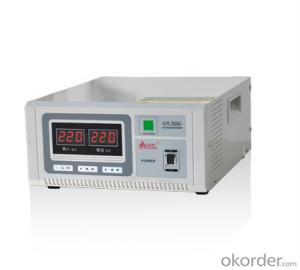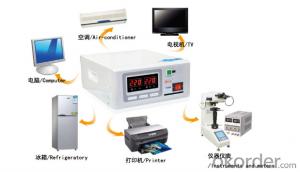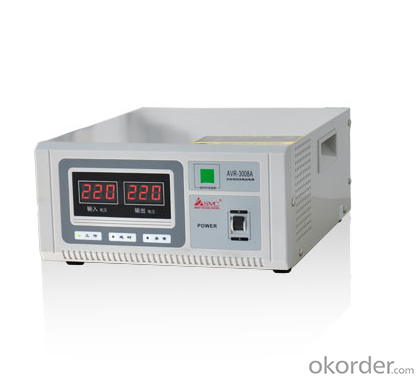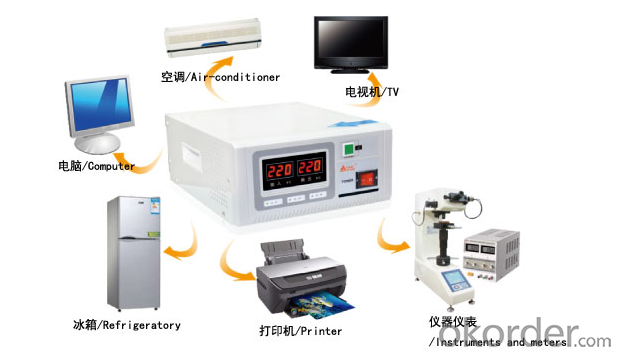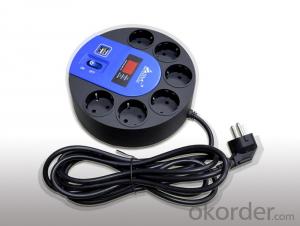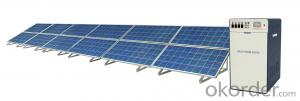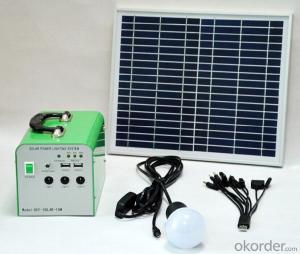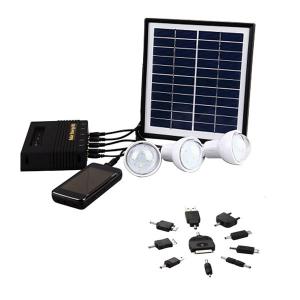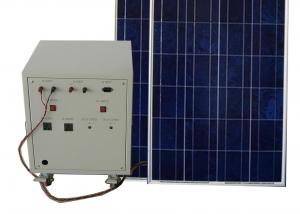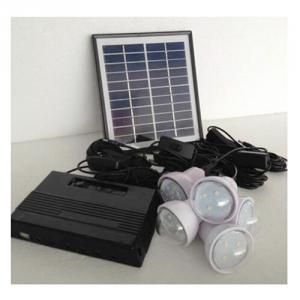Commercial Solar Energy Systems CVoltage Stabilizer Circuit Diagram 5kV Automatic Voltage Stabilizer
- Loading Port:
- China main port
- Payment Terms:
- TT OR LC
- Min Order Qty:
- 20 carton
- Supply Capability:
- 10000 carton/month
OKorder Service Pledge
OKorder Financial Service
You Might Also Like
Unipower circuit diagram 5kv automatic voltage stabilizer

Product Description

| Model | AVR-1008A | AVR-2008A | AVR-3008A | AVR5008A |
| Rated power | 1000VA | 2000VA | 3000VA | 5000VA |
| Display | LED or LCD, depends on user's choice | |||
| TECHNOLOGY | ||||
| Technology | CPU Based Digital Circuit + Transformer + Ralays | |||
| Efficiency | 98% | |||
| Phase | Single | |||
| INPUT | ||||
| Input voltage range & frequency | 140~280VAC/Same as AC | |||
| OUTPUT | ||||
| Output voltage range | 220VAC±10% | |||
| DISPLAY | ||||
| LED digital display status | Input voltage, output voltage | |||
| LED display status | Normal, Display, Fault | |||
| PROTECTION | ||||
| Protections | Over & low voltage, overload, high temperature, short circuit | |||
| ENVIRONMENT | ||||
| Environment of performance | Temperature 0℃~40℃, Humidity 20%~90% | |||
| Noise level | Less than 40dB | |||
| PHYSITAL | ||||
| (kg) / Net weight (kg) | 4.5 | 6.0 | 10 | 13.0 |
| (mm) / Unit dimention (mm) | 251*255*120 | 315*255*120 | ||

1. Wide range of input voltage
The UPS can offer normal and stable service voltage under its input voltage range. When the input voltage is out of its range the machine will switch to battery mode automatically to keep the output power in order to protect the equipment, such as computers, ensure they will not be damaged by the over high or over low voltage, users can continue the operation of equipment for a while or save the data on computers while the power network is abnormal.
2. Wide range of AVR(Automatic voltage regulation)
In the product’s input voltage range and under 3 steps of intelligent AVR function, it can provide a stable output voltage.
3. Automatic self detection when UPS on(LED).
Before the UPS on, red, yellow, blue LED will light up two times by cycle turns, after self detection UPS switch to AC mode/battery mode or working mode.
4. Silence function
In the "battery mode", shortly press the switch to turn off the buzzer. But the battery is about to run out or the load is too heavy, the buzzer sound cannot be muted.
5. Overload protection
In the battery mode, output voltage turn down correspondingly when it is overload, after the capacity of load is lower than the rated power then output voltage will back to rated value, it ensures the UPS will not shut down by abrupt overload which caused by surging current during the computer is working and other equipment is added.
6. Short circuit protection
When the mis-operation caused the load short circuit or computer failure (such as power tube breakdown of switch) cause short circuit, the UPS will shutdown automatically for protection.
7. The low current switch
This UPS adopts low current switch to extend the service life which is longer than conventional battery and high current switch in AC current path.
8. Automatic charging
There are two charging mode, charging time is faster than ordinary charging mode, higher efficiency, and greatly prolonging the service life of the battery.
9. With a bypass output
Independent bypass output socket for external printers or scanners of computer peripherals, with surge protection of the load.
- Q: Can solar energy systems be used in areas with limited water supply?
- Yes, solar energy systems can be used in areas with limited water supply. Solar energy systems, such as photovoltaic panels, do not require water for their operation. Unlike other forms of energy generation like thermal power plants, which rely on water for cooling and steam generation, solar energy systems can function efficiently with no or minimal water usage. This makes solar energy a viable and sustainable option for areas facing water scarcity or limited water supply.
- Q: Can solar energy systems be used in areas with limited financial resources?
- Yes, solar energy systems can be used in areas with limited financial resources. These systems have become increasingly affordable and accessible over the years, with various financing options and government incentives available to support their installation. Additionally, solar energy can help reduce electricity bills in the long run, providing a cost-effective and sustainable energy solution for communities with limited financial resources.
- Q: Can solar energy systems be used in urban areas?
- Yes, solar energy systems can be used in urban areas. While space constraints and shading from buildings may pose some challenges, solar panels can still be installed on rooftops, balconies, or even integrated into the facades of buildings. Additionally, advancements in solar technology have led to the development of more compact and efficient systems that can generate electricity even in limited sunlight conditions. Hence, urban areas can greatly benefit from harnessing solar energy to reduce reliance on traditional power sources and promote sustainability.
- Q: Can solar energy systems be used in areas with limited access to solar energy maintenance services?
- Yes, solar energy systems can be used in areas with limited access to solar energy maintenance services. While regular maintenance can optimize the performance and longevity of solar systems, modern solar panels are designed to be durable and require minimal maintenance. Additionally, advancements in remote monitoring technology allow for easy identification of any issues, enabling timely repairs or maintenance visits. Moreover, training local technicians and establishing community-based maintenance programs can help overcome limited access to professional services, ensuring the sustained operation of solar energy systems in such areas.
- Q: How do solar energy systems contribute to reducing the risk of power outages during extreme weather events?
- Solar energy systems contribute to reducing the risk of power outages during extreme weather events by providing a decentralized and reliable source of electricity. Unlike traditional power grids that are vulnerable to damage from storms, solar energy systems operate independently and can continue generating power even if the main grid goes down. This means that even during severe weather events, such as hurricanes or snowstorms, solar panels can still supply electricity to homes, businesses, and critical infrastructure, reducing the reliance on centralized power sources and minimizing the impact of power outages.
- Q: Can solar energy systems be used in areas with limited sunlight?
- Yes, solar energy systems can still be used in areas with limited sunlight. While solar panels may not generate as much electricity as they would in sunnier regions, they can still produce a significant amount of energy. Additionally, advancements in solar technology, such as the use of more efficient panels and energy storage solutions, have made it possible to harness solar power even in areas with less sunlight.
- Q: Can solar energy systems be used for large-scale power generation?
- Yes, solar energy systems can be used for large-scale power generation. Solar photovoltaic (PV) power plants, also known as solar farms, are capable of generating a significant amount of electricity. These power plants consist of a large number of solar panels that convert sunlight into electricity. With advancements in technology and economies of scale, the efficiency and cost-effectiveness of solar energy systems have improved, making them viable for large-scale power generation. Additionally, solar energy is a renewable and clean source of power, making it an attractive option for reducing carbon emissions and transitioning to a more sustainable energy future.
- Q: Solar power generation system suitable for home, how much is the cost of a set?
- Solar photovoltaic power generation is suitable for families but to look at your location and sunshine time, before the country without a policy or honest with general electric, energy saving is a national matter we the people pay so without saving
- Q: How do solar energy systems impact the health of the population?
- Solar energy systems have a positive impact on the health of the population. They help reduce air pollution by replacing fossil fuel-based power generation, which leads to improved air quality and decreased respiratory ailments. Additionally, solar energy systems do not emit harmful greenhouse gases, reducing the risk of climate-related health issues such as heat strokes and vector-borne diseases. By providing clean and sustainable energy, solar systems contribute to a healthier and more sustainable future for all.
- Q: How do solar energy systems impact community resilience?
- Solar energy systems can have a positive impact on community resilience by providing a reliable and sustainable source of power. These systems can help to decrease dependence on fossil fuel-based electricity, reducing vulnerability to power outages and price fluctuations. Additionally, solar energy can be generated locally, promoting energy independence and enabling communities to become more self-sufficient. In the event of natural disasters or emergencies, solar energy systems can continue to function, providing critical electricity for essential services and helping communities to recover more quickly. Overall, solar energy systems contribute to building stronger and more resilient communities by ensuring access to clean and reliable energy.
Send your message to us
Commercial Solar Energy Systems CVoltage Stabilizer Circuit Diagram 5kV Automatic Voltage Stabilizer
- Loading Port:
- China main port
- Payment Terms:
- TT OR LC
- Min Order Qty:
- 20 carton
- Supply Capability:
- 10000 carton/month
OKorder Service Pledge
OKorder Financial Service
Similar products
Hot products
Hot Searches
Related keywords
